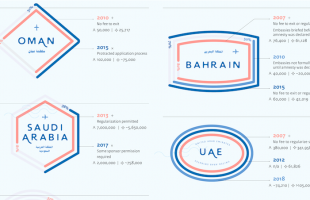The Saudi crackdown has impacted migrants across a spectrum of nationalities, but here we focus on two groups facing particularly adverse reverberations of Saudi’s unrelenting crackdown, in part due to pre-existing predicaments and mismanaged policies of their origin countries.
Saudi’s deportations compounded the pre-existing humanitarian crisis at the Yemen-Saudi border, a frequent crossing-point for economic migrants prior to post-Nitaqat securitization. Over 51,000 Ethiopian migrants arrived in North Yemen this year alone, and since July, over 25,0o0 have been stranded following their forced return to the border town of Haradh. Many of these migrants reported abuse at the hands of border agents or traffickers.
The International Organization for Migration (IOM) has worked to provide services and repatriation to migrants, but pre-existing funding shortages have been exacerbated by the recent expulsion of thousands of Ethiopian migrants. The IOM has funding to assist only those in the most severe conditions.
So far, over 100,000 Ethiopians have already been repatriated by the Ethiopian government and the IOM. The IOM predicts the repatriation of at least 50,000 Ethiopian migrants will conclude by conclude by mid-december.
At least two Ethiopians have died in clashes with citizens and police. Video-clips of the Manhoufa incident as well other evidence of brutality went viral, eliciting a strong response from the Ethiopian diaspora. The troubling video below is just one of several uploaded to YouTube within the past two weeks. Transcribed in English, Ethiopian migrants express their fear of 'vigilante' citizens:
Protests erupted across the globe against the mistreatment of Ethiopian migrants as well as the Ethiopian government’s failures to protect its overseas citizens. Explosive social-media reactions brought long enduring issues to the forefront of Ethiopian and international discourse.
Yemeni migrants encountered similar predicaments, an estimated 80% having traveled into – and now out of - Saudi Arabia undocumented, via the same route. Yemeni and Saudi authorities predicted the weight effect of Nitaqat on Yemeni migrants, though neither pursued significant strategies to alleviate the repercussions. Over 30,000 Yemeni migrants were deported by May, prior to the end of the amnesty period, and over 55,000-73,000 are estimated to have been deported or otherwise returned after the amnesty, some having faced protracted detention. Yemen analysts predict the number of returnees could reach 1,000,000.
Yemeni citizens similarly criticized the Yemeni government’s failure to adequately provision support to citizens during and after the amnesty period, subjecting them to perilous raids and mass deportations. Criticisms have also been lodged against the estimated $2.3 million used to host the ministry of expatriates’ conference, which could have been used to assist migrants and facilitate their re-entry into Yemen’s economy.
One deported Yemeni migrant is reported to have committed suicide upon his return. Even those who sympathize with migrants’ humanitarian and economic plight, question why so many thousands of migrants failed to ‘take advantage’ of the amnesty, or why they ‘failed to plan’ for deportation. The corrective period did not apply to migrants who had entered the country ‘illegally’ – these migrants could only pursue repatriation without financial penalty, but could not obtain other employment. This meant giving up work to secure exit visas from embassies, and it meant potential detainment upon ‘turning themselves in,’ or being left to the whims of bureaucracy - many migrants who sought amnesty were left in makeshift camps for weeks, as governments tried to source money for their repatriation. Those who could legally correct their status may still have faced obstacles in obtaining a transfer of sponsorship, particularly difficult for part-time workers who are not recognized under the sponsorship system, despite the demand for their work.
Still, some hold that undocumented migrants must face the repercussions of their ‘choices’, that the Kingdom cannot be held accountable for their consequent legal or financial issues. Yet this perspective obscures the structural causes of undocumented migration. Without subverting migrants’ agency, it must be recognized that this “choice” is engendered by the policies created by the Saudi government itself. Many migrants were forced to work without visas by employers who wished to avoid sponsorship costs, or to circumvent recruitment quotas. During the amnesty, many were unable to correct their status because their employers would not issue them visas, in an attempt to avoid extra fees.
And while migrants face disproportionate, permanent penalties for the perceived unintended consequences of these very deliberate structures, Saudi continues to benefit from the fruits of their labor. As an anonymous Saudi contractor incisvely observed:
“These people have worked in this country and their blood is in the stones and buildings.”
Furthermore, though states hold the right to detain and deport undocumented migrant workers, international conventions stipulate minimum standards for their implementation. According to the IOM
“Many returnees have been brought to the border with no belongings, sometimes barefoot, and often dehydrated and exhausted due to overcrowding while detained and transported by the Saudi authorities.”
35% of Yemeni migrants also reported theft and beatings by Saudi border authorities. Migrants are not empowered by regular, or even minimal, access to translators, lawyers, or even the opportunity for recourse and most origin embassies are incapacitated, or corrupted, to support the profusion of cases from their constituency. Migrants are consequently left to the whims of Saudi agents, who are fully aware of their effective impunity; unsurprisingly, the minimal regulation and accountability systematically exposing migrants to abuse at the borders mirrors the Kafala’s systems effects within the Kingdom.
The issues facing both migrant groups are the result of chronic issues that exploded following the crackdown; Saudi’s unrelenting deportations, in combination with the unpreparedness of origin countries, exacerbated the difficulties migrants faced. Their experiences evidence the need to eschew ‘crackdown’ strategies and address irregular migration from a rights based approach, to work closely with origin countries, as well as the growing importance of diaspora networks in unifying strategies for accountability and solidarity.




